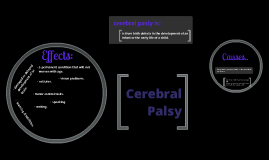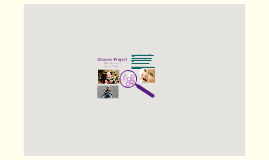Cerebral Palsy
Transcript: Treatment There is no cure for cerebral palsy. The goal of treatment is to help the person to be as independent as possible. Treatment requires a team approach, including: primary care doctor, dentist(dental check-ups are recommended every six months), social worker, nurses, occupational, physical, and speech therapists, other specialists, including a neurologist, rehabilitation physician, pulmonologist, and gastroenterologist. Treatment is based on the person's symptoms and the need to prevent complications. Self and home care include: getting enough food and nutrition, keeping the home safe, performing exercises recommended by the health care providers, practicing proper bowel care(stool softeners, fluids, fiber, laxatives, regular bowel habits), protecting the joints from injury. Putting the child in regular schools is recommended , unless physical disabilities or mental development makes this impossible. Special education or schooling may help. There are items that may help with communication and learning, such as glasses, hearing aids, muscle and bone braces, walking aids, wheelchairs. Symptoms Cerebral palsy is caused by injuries or abnormalities of the brain. Most of these problems occur as the baby grows in the womb, bu they can happen at any time during the first two years of their life, while the baby's brain is still developing. In some people with cerebral palsy, parts of the brain are injured due to lack of oxygen in the area. Premature infants along with fetuses that are exposed to infections such as rubella (German Measles) have an increased rick of developing CP. Cerebral palsy may also occur during early infancy as a result of several conditions, including: bleeding in the brain, brain infections(encephalitis, meningitis, herpes simplex infections), head injury, infections in the mother during pregnancy(rubella), and severe jaundice. In some cases the cause of cerebral palsy is never determined. Cerebral palsy has many complications such as: bone thinning or osteoporosis, bowel obstruction, hip dislocation and arthritis in the hip joint, injuries from falls, joint contractures, pneumonia caused be choking, poor nutrition, reduced communications(sometimes), reduced intellect(sometimes), scoliosis, seizures(in about half of patient numbers), and social stigma. By: Ante and James Symptoms are usually seen before a child is two years old, and sometimes begin as early as three months. Parents may notice that their child is delayed in reaching, and in developmental stages such as sitting, rolling, crawling, or walking. Because there are many types of cerebral palsy, there are many symptoms but most are similar for each type. Common symptoms are: muscle weakness or loss of movement in a group of muscles(paralysis), abnormal movements such as twisting, jerking, or writhing of the hands, feet, arms, or legs while awake, which proceed to become worse in periods of stress, tremors, unsteady gait, loss of coordination, floppy muscles, especially at rest, and joints that move around too much. Other brain and nervous system symptoms include: decreased intelligence or learning disabilities, speech problems, hearing or vision problems, seizures, pain, especially in adults, which can be very difficult to manage. Other symptoms include: slower than normal growth, irregular breathing, urinary incontinence, eating and digestive problems such as problems swallowing, vomiting or constipation. Getting the proper prenatal care may reduce the risk of some rare causes of cerebral palsy. However, dramatic improvements in care over the last fifteen years have not reduced the rate of cerebral palsy. In most cases, the injury causing the disorder may not be preventable. Pregnant mothers with certain medical conditions may need to be followed in a high-risk prenatal clinic. http://www.ncbi.nlm.nih.gov/pubmedhealth/PMH00011734/?report=printable Peacock, Judith, Cerebral Palsy, LifeMatters, 2000 How to identify and diagnose Cerebral Palsy Bibliography WHAT IS CEREBRAL PALSY? Cerebral Palsy Prevention Cerebral Palsy is a group of disorders that can involve brain and nervous system functions, such as movement, learning, hearing, seeing, and thinking. There are several different types of cerebral palsy, including spastic, dyskinetic, ataxic, hypotonic, and mixed. The word "cerebral" refers to the brain. The word "palsy" refers to weakness of the muscles. The brain's motor centers normally control the muscles. The brain sends messages to the spinal cord. The spinal cord relays the messages to the nerves that lead to the muscles. People with cerebral palsy have motor problems because of damage to the brain's motor centers. A worst case scenario is when a child cannot control his/her muscles at all and will need to be looked after for the rest of their lives. There are many different types of cerebral palsy. Complications

















